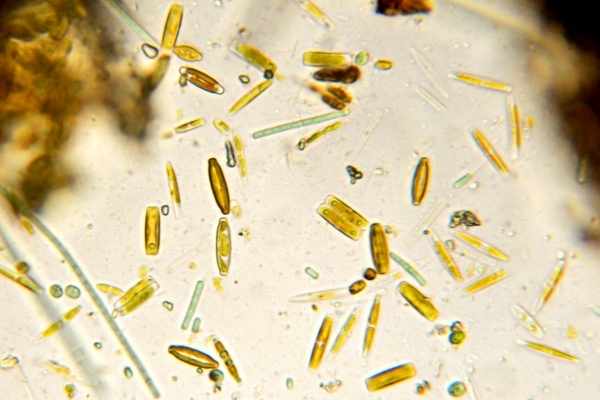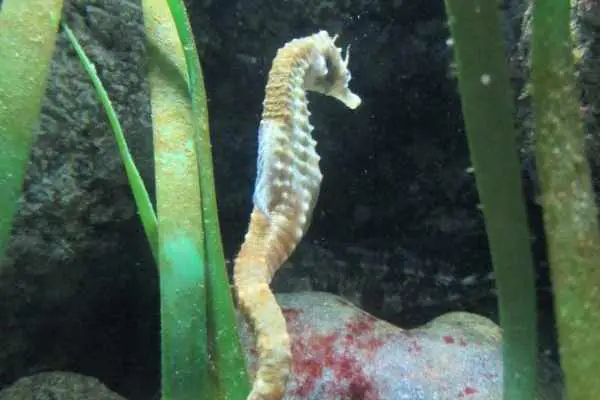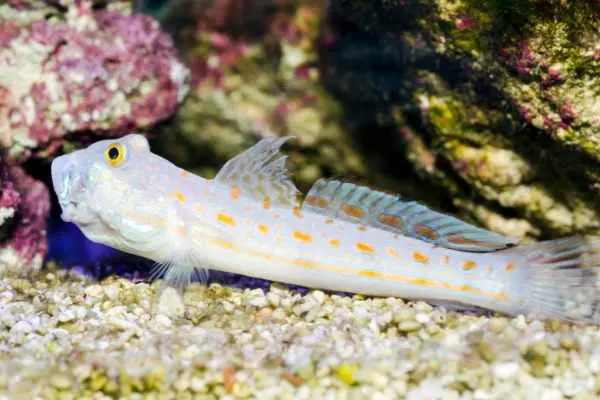Have you spotted clusters of unwanted patches of brown growth in your tank? Brown algae probably come to mind first. (Quick-growing, plant-like, covering EVERY surface) What if I told you those growths were a particular group of algae known as diatoms. And eradicating them from your saltwater aquarium can get tricky. Because diatoms exist EVERYWHERE. (No, seriously)
Table of Contents: Removing Brown Algae/Diatoms
Whether you started with freshwater tanks and made the transition to saltwater, or you jumped straight to the marine world, you’ve encountered brown algae. And whether you choose to call them that or the more accurate label of diatoms, you know the growths are a pain to deal with. The fuzzy, brown patches show up in unlikely places! If you feel mystified, you’ve come to the right place. These links will guide you through everything you need to know (or could want to know).
- What is Brown Algae?
- Recognizing Brown Algae/Diatoms in Your Tank
- Preventing Brown Algae/Diatoms
- Removing Brown Algae/Diatoms
- For More Information

What is Brown Algae?
Brown algae belong to the Class Bacillariophyceae. And, unlike the macroalgae you cultivate for your herbivores, they’re unicellular. That means they’re single-celled. They also build cell walls from silica. That sets them apart from your “true algae,” which use chitin. (Trust me, that nugget of information will become important)
Now, brown algae and other species both use chloroplasts to carry out photosynthesis. It just happens that the chloroplasts in the varieties that take up residence in tanks are brown. Hence the name “brown algae” that most hobbyists use to describe them. If you go to the scientific world, though, they use a different term: diatoms.
Diatoms: Unicellular Algae
Diatoms show up everywhere you can think of:
- Rivers, lakes, ocean
- Soil
- Rocks
- Snow
- Geysers
The solar energy they create in those brown chloroplasts makes them a crucial part of the food web. So it’s not a surprise they tip the scale as the biggest group of algae. Actually, they’re kind of a big deal in A LOT of respects. Diatoms make up HALF the ocean’s biomass (that’s a QUARTER of the organic material on the planet, by the way). And the photosynthesis that results? It produces TWO-THIRDS of the planet’s oxygen.
So, yes, it’s annoying to find diatoms in your reef tank. But those diatoms play pivotal roles on our planet.
To date, scientists have discovered over 300 different genera of diatoms. They divide them into centric (circular) and pennate (elongated). Most of the time, hobbyists deal with pennate diatoms. Specifically, those in the Navicular group. Viewed under a microscope, they have tapered edges. Navicular diatoms make up the bulk of the aquatic species inhabiting the plankton.
(Okay, so odds are you won’t break out a microscope to check the shape of your brown algae. It’s simply a nerdy fact to tuck into your brain)
Diatomaceous
The silicon shell of a diatom persists LONG after the alga passes away. It’s heavy, though, so it sinks to the bottom. And over time, all of those shells build up along the ocean floor. Continue the process for, say, a few million years, and what do you get? Deposits of diatomaceous silt. The collected silicon shells provide handy resources for products we use every day:
- Filters
- Paints
- Polishes
- Toothpaste
Or you can harvest straight diatomaceous earth for your garden. Many people find those “leftover” diatoms handy for repelling fleas and other household pests. (And they’re natural – no nasty chemicals)
Then there’s the other use for those diatomites (compressed silicon shells). What do you think you get if you impress some nitroglycerin into them? You got it – dynamite!
Of course, you probably don’t want to wait for your brown algae to die and collect on the bottom of your tank to start a new enterprise. (Also, you’ll end up with unwanted side effects on your water quality)
So while diatoms pull their weight in our industrial world, they usually fall in the “pest” category for saltwater aquariums.
(But it’s pretty cool to find a nuisance that does good out in the world, isn’t it?)

Recognizing Brown Algae/Diatoms in Your Tank
Recognizing brown algae in your saltwater tank gets tricky. After all, it IS part of the algae family. And unless you have a quality microscope handy, you’re not going to see those silica cell walls. Looking for the brown color isn’t an accurate tip-off, either. Plenty of other species of algae look similar. (And calling for an embargo on everything algal isn’t the solution – we’ll go into why in a few minutes)
Even worse, some species of cyanobacteria resemble patches of diatoms. Now, you don’t want cyanobacteria in your tank, EITHER, but the two behave differently. One, cyanobacteria produce tiny bubbles along the surface of the colony. (Yes, you need to get close to see) Two, brown algae don’t form “sheets” within your aquarium. Patches, yes, but not sheets.
Now, this experiment should ONLY be performed to confirm the presence of diatoms within your tank. And you should take care when you do so to prevent a potential new colony of cyanobacteria (in case you’re wrong).
- Wearing gloves, try to peel up a piece of the suspected brown patch.
- Does it come off nicely in a clump?
- STOP!
You’ve got cyanobacteria. You don’t want the clump to break and introduce new colonies throughout the tank.
If you can’t peel anything, and you just end up rubbing off something grainy, then you’re dealing with brown algae. You don’t need to worry about infesting the remainder of the aquarium, but you should focus on cleaning things up. And the “grit” you notice? Those are those silica shells. (You may or may not be able to tell, depending on the thickness of your gloves)
Preventing Brown Algae/Diatoms
If you’re hoping never to see brown algae in a tank, you’re out of luck. Those tiny diatoms THRIVE in water – ANY water. Actually, they thrive anywhere, as we already discussed. And that means it doesn’t take much to introduce them to an aquarium. However, if you’re avoiding the worst offenses, you shouldn’t see an overgrowth of the pest.
Before we go into the best ways to prevent brown algae, one caveat: If you’re starting to cycle your aquarium, take a deep breath. It’s EXTREMELY common for diatoms to make an appearance in a new tank. With a nitrogen cycle out of whack, water parameters shift daily. You often find excess nitrates, phosphates, and (yes) even silicates. That’s the perfect environment for brown algae to thrive.
As things balance out, the diatoms will slowly die. And the system will account for the addition of THAT waste. You’ll see those brown patches disappear, and your levels will acclimate. By the time you’re ready to start introducing fish and invertebrates, you shouldn’t have a problem. So don’t panic if you’re still waiting for your cycling to finish.
However, if you’re worried about your display aquarium, it’s time to take further preventative measures.
Water Quality
What do brown algae need to survive? A few key components:
- Nitrate
- Phosphate
- Silica
Keeping tabs on your water’s nitrate level will help prevent an unwanted diatom bloom. If you stay below the threshold of 20ppm, you’ll starve the algae of a favorite meal. Yes, they savor a “light” meal, but they also devour nitrates whenever possible. And if your tank’s nitrates creep up, you’ll provide the growth hormone needed to support a sudden surge of brown algae.
Phosphate’s a little trickier. Most hobbyists don’t always pay attention to this water parameter – unless they’re cultivating some of the more delicate corals. It tags along with calcium, sneaking its way into your tank. And if you’re not careful, you can end up with a level sufficient to satisfy the hunger of lurking diatoms. You don’t want to go out of the 0-0.03ppm range here. (Narrow, yes)
As to silica, that isn’t something you can test for (not easily, anyway). But diatoms require the element to build their cell walls. And they find it in places you don’t think to look. Such as your substrate and salt mix. Always read the labels carefully to see what percentage of silicate the brand contains. If you’ve dealt with brown algae in the past, you may need to make a change.
If you’re REALLY worried about the silica, consider introducing sponges. Sponges also need silica, and they’ll outcompete the diatoms. (Plus, they look MUCH nicer)
Filtration
Obviously, cleanliness matters when it comes to diatoms. The more chances they have to sniff out nitrates, the better YOUR chances of dealing with unsightly patches of brown algae. Avoiding overfeeding paves the way, but so does maintaining appropriate filtration.
Do you have a filter rated for your aquarium size? Are you using a sump to increase the filtration time and efficiency? Is it time to consider an extra filter?
The more nutrients you pull away from the diatoms, the less they’ll grow.

Water Movement
Unlike cyanobacteria, brown algae are on the delicate side. It doesn’t adhere to surfaces well. The silica shells move around via secretions of mucus – mucus that DOESN’T create a firm anchor. So the more water movement you have in your aquarium, the better your chances of preventing a diatom bloom.
Set up a few powerheads, and then watch where your current moves. You don’t want any dead zones. If you have pockets within the tank where water remains still, that’s the perfect place for brown algae to gain a foothold. You want to keep everything in motion. And you don’t even need to go for the “intertidal zone” setting. Any movement will prevent the diatoms from settling.
Reactors
If you’re still worried about brown algae encroaching on your tank, look into purchasing reactors and appropriate media for your tank. Since diatoms ARE so prevalent, media exists to eliminate silicates. Add it to your reactor, and you won’t need to worry about the tiny algae cells gaining a foothold. Popular choices include:
- Seachem Phosguard
- Seachem Phosbond
- Poly-Bio-Marine
DON’T use activated charcoal. Charcoal doesn’t remove nitrate, phosphate, OR silica. So while it WILL help with cleaning, it will leave the three compounds necessary for brown algae to survive.
Removing Brown Algae/Diatoms
Your tank finished cycling years ago. You have unsightly patches of brown algae in your aquarium. And they need to GO. Don’t panic. Unlike some unwanted saltwater pests, diatoms are easy to remove. The process won’t damage your tank or cause harm to the fish or other invertebrates. However, you need to decide how much time you feel like investing (or money).
Physical Removal
Nothing beats elbow grease when it comes to removing brown algae. However, there IS an art to the process. If you scrub around randomly, you’ll disperse the silica shells throughout your tank. It’ll leave you with more cleaning to do down the road. So grab your scrubbing pad of choice and a bucket of water (oh, and some patience).
Let’s start with the glass:
- Press the scrubby to the glass ABOVE the substrate.
- Holding pressure against the glass, pull straight up until you’re out of the water.
- Squeeze the scrubby into the bucket.
- Repeat until your glass is clean.
If you see brown algae on décor, remove the piece from the tank. You can then scrub it thoroughly. You won’t risk scattering diatoms everywhere. Since you’re not coping with anchors from the algae, you won’t need more than a toothbrush to get into the crevices.
For your substrate, you’ll need to break out your vacuum. (Yes, a gravel vacuum)
- Run the vacuum just ABOVE the substrate to collect any waste.
- Kink the hose to cut off ALMOST all of the suction.
- Stir up the sand with the vacuum wherever you see brown algae.
- Unkink the hose and suck up your “diatom cloud.”
- Repeat until your sand is clean.
Lighting
Now, boosting your lighting choices sounds insane. Brown algae WANT light. So why in the world would you give them something helpful? What you’re actually doing is increasing the resources of competitors. “True algae” (or, in this case, green algae) need broader light spectrums to live and grow. And if they get those conditions, they’ll spread through a tank.
If you have more green algae in your aquarium, they’ll use up the resources available to your diatoms. Before you panic over ANOTHER algae bloom, it’s okay. More fish and invertebrates eat these species. So you’ll supply a handy snack while eliminating your diatom problem. It gives you a chance to adjust any other issues (water quality, filtration, etc.).
And isn’t green a nicer color than brown?

Biological Warfare
In general, reaching for a “chemical” solution isn’t usually at the top of most hobbyists’ lists. However, sometimes brown algae are THAT annoying. Vibrant contains bacteria (natural bacteria; you’re not adding anything synthetic to your tank) that compete for the same resources as the diatoms. And bacteria are effective. Over time, they succeed at supplanting the algae.
This ISN’T a fast removal method, though. You need patience. So it’s up to you whether you feel the wait is worth it.
“Housekeeping”
Brown algae ARE algae. And what eats algae? Well, as it turns out, a few options:
- Cerith snails
- Diamond gobies
- Kole tangs
- Margarita snails
- Mexican turbo snails
- Trochus snails
Snails will happily roam your tank in search of new patches of diatoms to snack on. And they make short work of the invader. You may need to cope with a snail explosion afterward, though, so keep that in mind.
Kole tangs aren’t as large as some of their cousins. This makes them a more reasonable “housekeeping” addition to a reef tank. But no tang is completely sweet and innocent. Before you rush to the fish store, ensure you’re ready to handle that famous surgeonfish attitude.
As for the diamond gobies, they LOVE sifting sand. They’ll keep your substrate clean of brown algae. But they’re not much for scouting around the remainder of the tank. And you WILL need to offer them a deep sand bed to keep them happy. It’s a matter of weighing the pros and cons (but you find that with every species).
For More Information
Brown algae won’t harm your fish. It CAN cover coral and live rock if allowed to grow out of control. And dying diatoms WILL send your silica level rising. But now you know how to deal with the familiar intruder. And if you’re still unsure about what to do with this unsightly aquarium problem, don’t fret. There’s still a little more to say on the topic.
Such as this YouTube video explaining how to beat brown algae in saltwater aquariums:
Or this one, which offers more information on removing diatoms:
Ready to get into some of the equipment that will help keep your tank in pristine condition?
Conclusion
Diatoms provide plenty of benefits to the planet. They add oxygen to the air we breathe through their daily photosynthesis. They’re the first piece of the giant food webs in the ocean. And those teeny-tiny silicon shells? They pile up, compact, and go on to become pieces of products we use every day.
Not too shabby for a single-celled alga.
But when you’re confronting them in your saltwater aquarium as brown algae, it’s time for them to go. They look unattractive, and they can interfere with the tank’s health. Good thing it’s NOT difficult to remove this particular alga.
Well, provided you’re patient.
References
- Alverson, A. 2014. “The Air You’re Breathing? A Diatom Made That.” LiveScience.
- Cock, J.M., Peters, A.F., and Coelho, S.M. 2011. “Brown Algae.” Current Biology.
- Montsant, A. Jabbari, K., Maheswari, U., and Bowler, C.. 2005. “Comparative genomics of the pennate diatom Phaeodactylum tricornutum.” Plant Physiology. 137(5). 500-513.


Leave a Reply